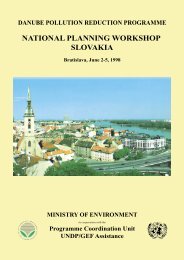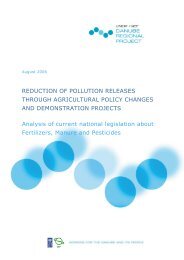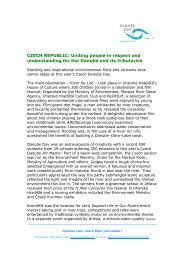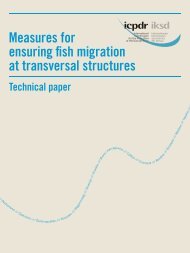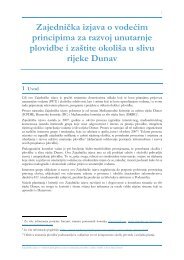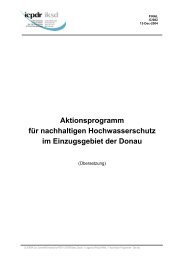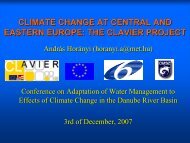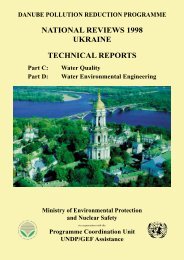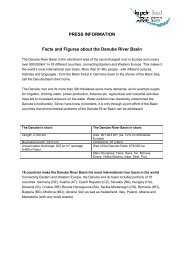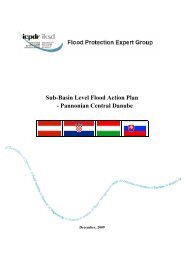Final Report - ICPDR
Final Report - ICPDR
Final Report - ICPDR
Create successful ePaper yourself
Turn your PDF publications into a flip-book with our unique Google optimized e-Paper software.
4.1.3 Inorganic micropollutants in suspended solids, sediment and mussels<br />
IWACO (2000) proposed limit values for heavy metals in sediment of the Danube<br />
river basin:<br />
Metals Unit Limit value in sediment<br />
Zinc mg/kg 200<br />
Copper mg/kg 50<br />
Chromium mg/kg 100<br />
Lead mg/kg 100<br />
Cadmium mg/kg 1<br />
Mercury mg/kg 0.5<br />
Nickel mg/kg 50<br />
Arsenic mg/kg 40<br />
The heavy metal concentrations varied in a wide range depending on the type of the<br />
samples and the type of heavy metal. Figures 4.1.3.1-11 summarize the different<br />
heavy metal concentrations in suspended solids, sediment and different mussel<br />
species collected in the Tisza (yellow) and its tributaries (red), respectively. Figures<br />
are grouped in one page indicating the amounts of the same pollutant measured in<br />
the three different investigated compartments. In case of mussels the use of<br />
logarithmic scale on Y axis is more demonstrative and advisable at the same time,<br />
because the differences in the order of magnitudes are illustrated only by that way.<br />
Altogether the three most frequently found mussel species were selected for the<br />
inorganic and organic micropollutant analysis, depending on which of them was<br />
present in the given sampling location. Data on Unio tumidus, U. pictorum and U.<br />
crassus are available as the results of the ITR program referring to the Tisza and its<br />
tributaries.<br />
Mercury (Hg) limit concentration was exceeded in the suspended solids and bottom<br />
sediment of the tributary Sajó. The amount of 1,3 mg/kg measured in the suspended<br />
solids is almost the double than in the sediment sample (0,75 mg/kg). It is a very<br />
clear phenomenon, which indicates historic (former) mercury pollution. During<br />
flooding the mixing up causes resuspension. Heavy metals could be remobilized from<br />
the deposited sediment layer and transported further downstream along the river at<br />
any time.<br />
There are no important differences among the three commonly occurring mussel<br />
species in terms of the investigated mercury concentrations (Figure 4.1.3.1). It is<br />
interesting that a slight decrease is detected in the upstream direction. The range of<br />
mercury concentration is generally below 0,1 mg/kg. The tributaries represent the<br />
same degree of pollution; the Zagyva contains the lowest mercury value (in Unio<br />
tumidus).<br />
The cadmium (Cd) concentration was dominantly well above the 1 mg/kg limit value<br />
both in the suspended solids and sediments of Tisza River (3-5 mg/kg), a bit higher<br />
values were found in the sediment (Figure 4.1.3.2). The sediment of Szamos has the<br />
maximum Cd value (7 mg/kg). Higher amounts (approaching and exceeding 10<br />
mg/kg) were measured in the different mussels especially in case of mussels<br />
27



